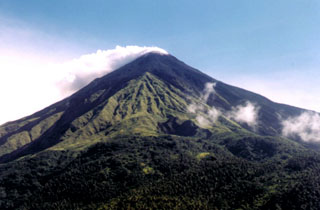Report on Karangetang (Indonesia) — 8 January-14 January 2025
Smithsonian Institution / US Geological Survey
Weekly Volcanic Activity Report, 8 January-14 January 2025
Managing Editor: Sally Sennert.
Please cite this report as:
Global Volcanism Program, 2025. Report on Karangetang (Indonesia) (Sennert, S, ed.). Weekly Volcanic Activity Report, 8 January-14 January 2025. Smithsonian Institution and US Geological Survey.
Karangetang
Indonesia
2.781°N, 125.407°E; summit elev. 1797 m
All times are local (unless otherwise noted)
The Pusat Vulkanologi dan Mitigasi Bencana Geologi (PVMBG) reported that monitoring data and visual observations during December 2024 and 1-10 January 2025 indicated decreasing unrest at Karangetang. No avalanches were observed from either Main Crater or North Crater, and neither crater produced incandescence visible at night. North Crater occasionally produced white plumes that rose as high as 400 m above the summit and drifted in multiple directions. Weather conditions sometimes prevented visual observations. Seismicity decreased and was characterized by five deep volcanic earthquakes per day and five earthquakes indicating gas emissions per day. At 1800 on 11 January the Alert Level was lowered to 2 (on a scale of 1-4) and the public was advised to stay 1.5 km away from Kawah Dua (North Crater) and the Main Crater (South Crater) with an extension to 2.5 km along the W, SW, S, and SE flanks.
Geological Summary. Karangetang (Api Siau) volcano lies at the northern end of the island of Siau, about 125 km NNE of the NE-most point of Sulawesi. The stratovolcano contains five summit craters along a N-S line. It is one of Indonesia's most active volcanoes, with more than 40 eruptions recorded since 1675 and many additional small eruptions that were not documented (Neumann van Padang, 1951). Twentieth-century eruptions have included frequent explosive activity sometimes accompanied by pyroclastic flows and lahars. Lava dome growth has occurred in the summit craters; collapse of lava flow fronts have produced pyroclastic flows.
Source: Pusat Vulkanologi dan Mitigasi Bencana Geologi (PVMBG, also known as CVGHM)

